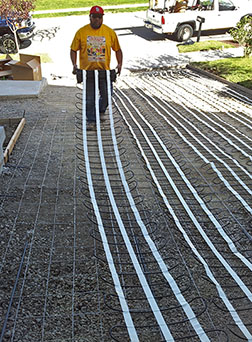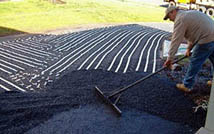Tips for Proper Installation of Heated Driveways and Walks
A radiant heated driveway is only as good as its installation, which is why it’s important to carefully follow best practices when installing radiant heat. Follow a few simple tips and your snow melting system will be up and running in no time, working as it was designed to do.
For starters, before you lay down a foot of heat cable, it’s important to make sure you have the right products for your installation. Prior to any installation, check the voltage and the wattage of the heating cable (typically indicated on the box). If you’re unsure, you can always contact ProLine Radiant for confirmation and/or recommendations. We offer free installation support to help ensure that the installation process goes smoothly and properly.

A key practice to ensure the successful installation of a radiant snow melting system is to use a megohmmeter to perform OHM tests of the heat cable before removal from the box, during, and after the installation. This allows you to discover any potential problems as early as possible, saving you time and headaches, as well as ensure successful installation. Always document the results to maintain the manufacturer’s warranty.
Here are a few rules to remember as you begin the installation of your system:
| ● | Never cut, cross or overlap the heating cable. Heat cable should not be altered under any circumstances, as it may cause overheating, resulting in damage to the cable. |
| ● | Always embed the cable completely. Leave no air around the cable. |
| ● | Make sure to embed the factory splice (where the heating cable and power lead meet). |
| ● | Using a megohmmeter, perform OHM tests of the heat cable before removing the cable from the box, during the installation, and after the cable has been laid out. |
| ● | Always run the cold lead in conduit (power lead for the heating cable) – it is not direct burial. |
For asphalt applications, snow melting cables are normally covered by two inches of asphalt. To prevent heat damage, the asphalt should be allowed to cool to 220°F (105°C) before pouring directly onto the mats or cables. Ground sensors/tubes should not be exposed to temperatures above 176°F (80°C).
And, for a proper sensor installation, both ground and aerial activation devices require a clear, 360-degree “view” of the sky to allow snow to fall onto the sensor plate. If drifting is an issue where the snowmelt system is being installed, it’s best to install a ground sensor.
Of course, you should always read the Installation Manual and follow instructions. You can always call ProLine Radiant at 866.676.9276 or visit us online for more information or installation support. At ProLine, we work with contractors and professional builders to provide customers with the best custom snow melting system solution at the best price possible.
Options and Tips for Installing Asphalt Heated Driveways
When it comes to installing a radiant heated driveway, installing a system in asphalt is one of the easiest applications available. The systems are not only easy to install in asphalt, but provide stellar performance, making asphalt heated driveways a popular choice among homeowners and business owners. Asphalt radiant heated driveways feature energy efficient, maintenance-free operation that enhances safety by keeping driveways clear of snow and ice 24/7. And radiant heat can be easily installed in new construction, asphalt refresh or even in existing driveways. Asphalt driveways offer great flexibility when it comes to adding or installing a radiant snow melting system. So regardless where you are in your plans, there’s still time to include a radiant heated asphalt driveway.
Asphalt and radiant snow melting systems go together for several reasons. They are both durable, and engineered to withstand extreme temperatures. They also adapt easily to the environment. Asphalt pavements flex and “give” with significant settlements of frost heave, while ProLine automated snow melting systems respond to the weather, operating only when conditions indicate that snow is on the way.

ProLine heat cable is specifically designed to withstand the hot temperatures of new asphalt construction jobs. And in keeping with ProLine’s commitment to always offer the latest technology and the best, most proven products, ProLine has taken its industry leading cable and added even more outstanding performance features. We listened to the comments and suggestions we received from you and other construction professionals during our FREE installation training courses to make your requests and made them a reality. This means our industry leading snow melting cable has now been enhanced to offer even more robust features, including the ability to install in much hotter asphalt temperatures, easier installation during cold weather conditions, an even tougher outer sheath and much more. Contact a ProLine representative to learn more about these latest advancements.
You see, at ProLine we are never content to be among the leaders. We might not achieve perfection, but we’ll never stop trying. We work tirelessly to research, test and develop the absolute best products possible to ensure that your business succeeds. And we can’t do that without your feedback and working closely with you during the installation process.
To install radiant heat in a new asphalt driveway, the cable is laid out on the binder or base coat and then hand shovel approximately 2-inches of asphalt directly over the cable. The asphalt is then compacted, using a 1-ton roller or less. Installing a heated asphalt driveway is relatively quick and easy. But remember, a snow melting system is only as good as its installation, so be sure to follow instructions and best practices, and don’t hesitate to take advantage of ProLine’s free installation support services. The fully automated heated driveway (or sidewalk) will provide a discreet, reliable and maintenance free operation to keep your walks and driveway snow and ice free.
If you’ve already got an asphalt driveway, but it’s in sore need of repair, placing an overlay on the existing surface can be easily accomplished. As with the new pour, ProLine snow melting cable can be installed just before the overlay. After a quick patch, apply asphalt as described above and compact. NOTE: Be sure to have a qualified electrician perform the electrical work. And follow the instructions in in the manual so ensure you keep your warranty valid.
Existing asphalt driveways can also be retrofitted with radiant heat. Using saw-cut technology, grooves are cut into the existing asphalt, and the heat cable is then placed in the freshly cut grooves. An epoxy topcoat is then applied as a sealant over the newly embedded cable. For additional traction and safety, a sand broadcast can be applied to the surface before the epoxy.
Fitted with a ProLine snow melting systems in asphalt provide a cost-effective option for your home, and will last for years with virtually no maintenance. Just think of the money you’ll save on snow removal services, snow melting chemicals and gas for your snow blower. And of course, there’s the gift of time. While your neighbors are out shoveling, snow blowing or tapping their watches waiting on their snow removal service, you’ll be in your car and on your way.
To learn more about the about the benefits of a radiant heated asphalt driveway or many radiant heat options available; or to receive a free quote, call ProLine Radiant today, at 866.676.9276.
